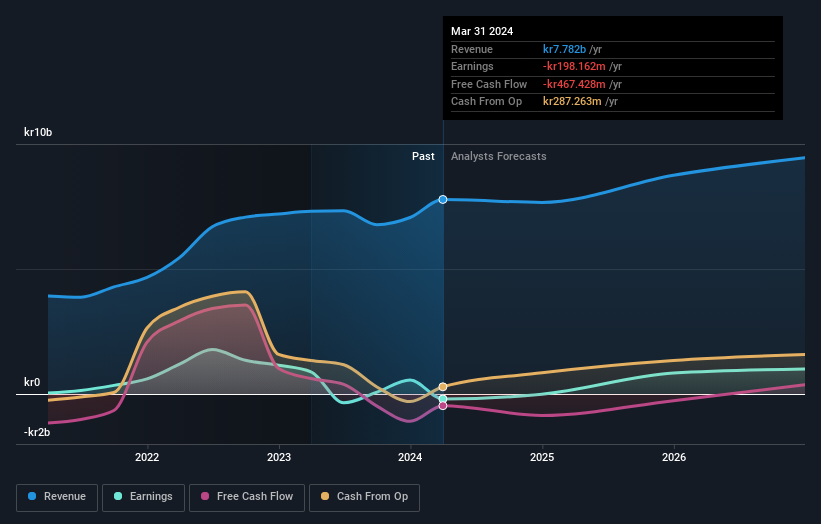Grieg Seafood ASA's (OB:GSF) stock price dropped 12% last week; private companies would not be happy

Key Insights
- Significant control over Grieg Seafood by private companies implies that the general public has more power to influence management and governance-related decisions
- The largest shareholder of the company is Grieg Maturitas AS with a 51% stake
- 16% of Grieg Seafood is held by Institutions
Every investor in Grieg Seafood ASA (OB:GSF) should be aware of the most powerful shareholder groups. And the group that holds the biggest piece of the pie are private companies with 58% ownership. In other words, the group stands to gain the most (or lose the most) from their investment into the company.
As market cap fell to kr7.3b last week, private companies would have faced the highest losses than any other shareholder groups of the company.
Let's take a closer look to see what the different types of shareholders can tell us about Grieg Seafood.
See our latest analysis for Grieg Seafood

What Does The Institutional Ownership Tell Us About Grieg Seafood?
Many institutions measure their performance against an index that approximates the local market. So they usually pay more attention to companies that are included in major indices.
We can see that Grieg Seafood does have institutional investors; and they hold a good portion of the company's stock. This implies the analysts working for those institutions have looked at the stock and they like it. But just like anyone else, they could be wrong. When multiple institutions own a stock, there's always a risk that they are in a 'crowded trade'. When such a trade goes wrong, multiple parties may compete to sell stock fast. This risk is higher in a company without a history of growth. You can see Grieg Seafood's historic earnings and revenue below, but keep in mind there's always more to the story.

Hedge funds don't have many shares in Grieg Seafood. Our data shows that Grieg Maturitas AS is the largest shareholder with 51% of shares outstanding. This implies that they have majority interest control of the future of the company. In comparison, the second and third largest shareholders hold about 4.6% and 1.9% of the stock. Nicolai Grieg, who is the third-largest shareholder, also happens to hold the title of Member of the Board of Directors.
Researching institutional ownership is a good way to gauge and filter a stock's expected performance. The same can be achieved by studying analyst sentiments. Quite a few analysts cover the stock, so you could look into forecast growth quite easily.
Insider Ownership Of Grieg Seafood
While the precise definition of an insider can be subjective, almost everyone considers board members to be insiders. The company management answer to the board and the latter should represent the interests of shareholders. Notably, sometimes top-level managers are on the board themselves.
I generally consider insider ownership to be a good thing. However, on some occasions it makes it more difficult for other shareholders to hold the board accountable for decisions.
We can see that insiders own shares in Grieg Seafood ASA. It has a market capitalization of just kr7.3b, and insiders have kr150m worth of shares, in their own names. This shows at least some alignment. You can click here to see if those insiders have been buying or selling.
General Public Ownership
The general public, who are usually individual investors, hold a 24% stake in Grieg Seafood. While this group can't necessarily call the shots, it can certainly have a real influence on how the company is run.
Private Company Ownership
It seems that Private Companies own 58%, of the Grieg Seafood stock. It's hard to draw any conclusions from this fact alone, so its worth looking into who owns those private companies. Sometimes insiders or other related parties have an interest in shares in a public company through a separate private company.
Next Steps:
It's always worth thinking about the different groups who own shares in a company. But to understand Grieg Seafood better, we need to consider many other factors. Take risks for example - Grieg Seafood has 1 warning sign we think you should be aware of.
Ultimately the future is most important. You can access this free report on analyst forecasts for the company.
NB: Figures in this article are calculated using data from the last twelve months, which refer to the 12-month period ending on the last date of the month the financial statement is dated. This may not be consistent with full year annual report figures.
New: Manage All Your Stock Portfolios in One Place
We've created the ultimate portfolio companion for stock investors, and it's free.
• Connect an unlimited number of Portfolios and see your total in one currency
• Be alerted to new Warning Signs or Risks via email or mobile
• Track the Fair Value of your stocks
Have feedback on this article? Concerned about the content? Get in touch with us directly. Alternatively, email editorial-team (at) simplywallst.com.
This article by Simply Wall St is general in nature. We provide commentary based on historical data and analyst forecasts only using an unbiased methodology and our articles are not intended to be financial advice. It does not constitute a recommendation to buy or sell any stock, and does not take account of your objectives, or your financial situation. We aim to bring you long-term focused analysis driven by fundamental data. Note that our analysis may not factor in the latest price-sensitive company announcements or qualitative material. Simply Wall St has no position in any stocks mentioned.
Have feedback on this article? Concerned about the content? Get in touch with us directly. Alternatively, email editorial-team@simplywallst.com
About OB:GSF
Grieg Seafood
Through its subsidiaries, operates as a fish farming company in Norway, the United Kingdom, rest of Europe, the United States, Canada, Asia, and internationally.
Undervalued with reasonable growth potential.


